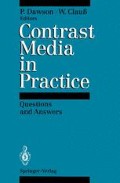Abstract
Since risk patients tolerate nonionic X-ray CM and effective premedications are available, previosly frequent side effects of CM examinations, such as nausea and vomiting, now occur rarely. Moreover, patients who have not had anything to eat or drink for longer periods of time are less calm and cooperative and more susceptible to side effects during an examination. In view of this, in 1992 a German group of radiological experts took up the question of optimal patient preparation, in the interests of both physician and patient and for the safety of the latter. A survey of the participating experts showed great discrepancies in the recommended periods of abstinence from solid food and liquids prior to intraarterial, intravenous, intrathecal, and intraarticular CM administration (Fig. 5.1.1 a-d); standardization therefore seemed desirable. After intensive, as well as controversial discussions, a recommendation was made to hydrate patients adequately both before and after CM administration, i.e. to urge the patient to drink. Moreover, for the administration of nonionic X-ray CM, sufficient reasons could no longer be found for maintaining the previously held recommendation of at least a 4-h absolute abstinence from food.
Access this chapter
Tax calculation will be finalised at checkout
Purchases are for personal use only
Preview
Unable to display preview. Download preview PDF.
References
Expertengespräch Kontrastmittel (1992) Radiologe 9 (Suppl)
Bielory L, Kaliner MA (1985) Anaphylactoid reactions to radiocontrast materials. Int Anesthesiol Clin 23: 97–118
Elke M, Brune K (1980) Prophylaktische Maßnahmen vor Kontrastmittelinjektionen. Dtsch med Wschr 105: 250–252
Lalli AF (1974) Urographic contrast media reactions and anxiety. Radiology 112: 267–271
Lalli AF (1980) Contrast media reactions: data analysis and hypothesis. Radiology 134: 1–12
Spring DB, Akin JR, Margulis AR (1984) Informed consent for intravenous contrast-enhanced radiography: a national survey of practice and opinion. Radiology 152: 609–613
Spring DB, Winfield AC, Friedland GW, Shuman WP, Preger L (1989) Written informed consent for iv contrast-enhanced radiography — Reply. Amer J Roentgenol 153: 189
Wangemann BU, Jantzen JP, Dick W (1988) Anästhesiologische Aspekte allergischer Reaktionen am Beispiel des „Kontrastmittelzwischenfalls“. Anaesth Intensivmed 29: 205–214
Albrecht K (1956) Das Risiko bei neurochirurgischen Untersuchungsmethoden. Zentralbl Chir 81: 2107–2113
Gottlieb A, Lalli AF (1982) Hypotension following contrast media injection during general anesthesia. Anesth Analg 61: 387–389
Jantzen JPA, Wangemann B, Wisser G (1989) Adverse reactions to non-ionic iodinated contrast media do occu during general anesthesia. Anesthesiology 70: 561
Maus H, Loennecken SJ (1962) Zerebrale Angiographie und Narkose. Fortschr Neurol Psychiatr 30: 155–165
Pfeifer G, Solymosi L, Grimm R, Wappenschmidt J (1984) Anästhesie in der Neuroradiologie. Anaesth Inten-sivther Notfallmed 19: 57–59
Plötz J, Viehweger G (1974) Die Angiographie der oberen Extremität in Narkose, lokaler und regionaler Anästhesie. Prakt Anaest 9: 225–231
Simmendinger HJ, Just OH (1973) Anaphylaktischer Schock nach Kontrastmittelinjektion. Z prakt Anaest 8: 370–374
Tolksdorf W, Raddi U, Rohowsky R, Lutz H (1980) Zur Wahl des Anästhesieverfahrens bei translumbalen Aortographien. Anaesth Intensivther Notfallmed 15: 400–406
Wangemann BU, Wisser G (1990) Prophylaxe des „Kontrastmittelzwischenfalls“ durch Allgemeinanästhesie? Radiologe 30: 141–144
Wisser G, Wangemann B, Jantzen JP, Dick W (1990) Anaphylaktoide Reaktion auf ein nichtionisches Röntgen-kontrastmittel in Allgemeinanästhesie. Anaesth Intensiv Ther Notfallmed 25: 271–273
Atkinson JP et al (1973) Effect of cortisone therapy on serum complement components. J Immunol 111: 1061–1066
Fiegel G (1985) Vermeiden von Kontrastmittelzwischenfällen. Med Welt 36: 1486–1470
Greaves MW et al (1974) Glucocorti-coid inhibition of antigen-evoked hist-amine release from human skin. Immu-nolgy 27: 359–364
Jennings JF et al (1966) The effect of hydrocortisone on immune lysis of cells induced by cytotoxic antibody and complement in vitro. J Immunol 96: 409–414
Lasser EC et al (1977) Theoretical and experimental basis for utilization in prevention of contrast media reactions. Radiology 125: 1–9
Schreiber AD et al (1975) Effect of cor-ticosteroids on the human monocyte IgG and complement receptors. J Clin Invest 56: 1189–1197
Weissman G (1961) Release of lysosomal protease by ultraviolet irradiation and inhibition by hydrocortisone. Exp Cell Res 25: 207–210
Wolf GL (1989) Adverse reactions to intravenous contrast media in routine clinical practice. Scientific Poster, RSNA 1989
Editor information
Editors and Affiliations
Rights and permissions
Copyright information
© 1993 Springer-Verlag Berlin Heidelberg
About this chapter
Cite this chapter
Clauβ, W., Taenzer, V., Wisser, G., Tauber, R. (1993). Prophylactic Measures. In: Dawson, P., Clauß, W. (eds) Contrast Media in Practice. Springer, Berlin, Heidelberg. https://doi.org/10.1007/978-3-642-97530-1_5
Download citation
DOI: https://doi.org/10.1007/978-3-642-97530-1_5
Publisher Name: Springer, Berlin, Heidelberg
Print ISBN: 978-3-540-57187-2
Online ISBN: 978-3-642-97530-1
eBook Packages: Springer Book Archive

